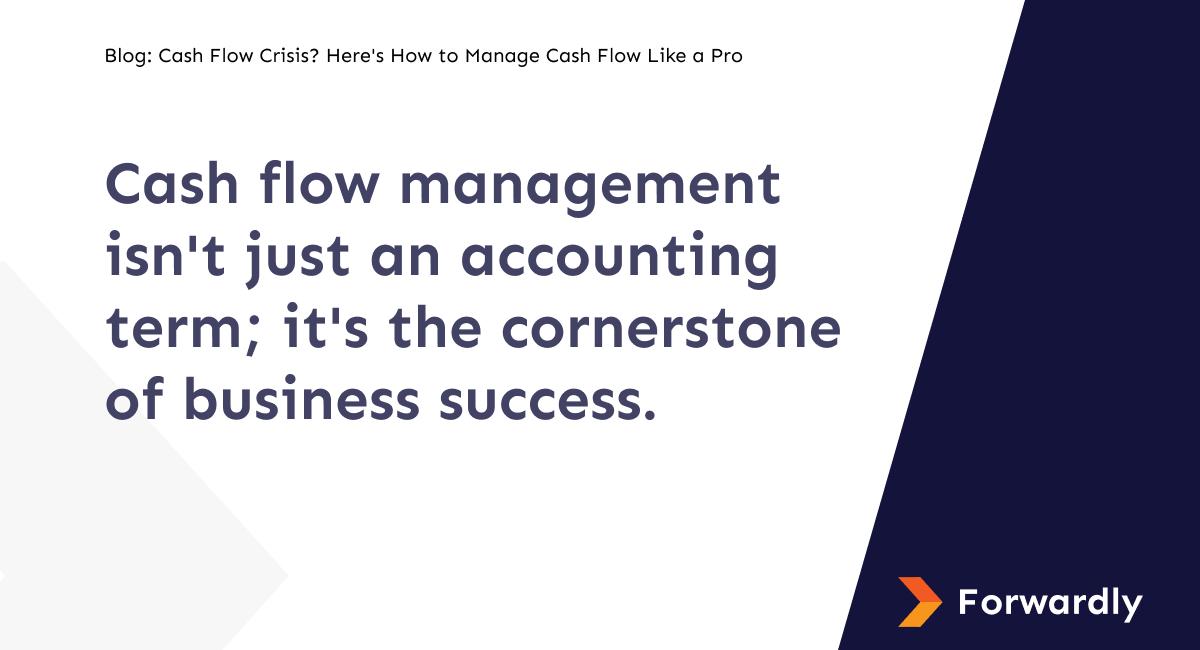Cash flow management isn’t just an accounting term; it’s the cornerstone of business success. Think of it as the financial circulatory system that keeps your business alive and kicking. Without it, even the most promising enterprises can grind to a halt. So, what makes it so important? In this article, we’ll delve into the world of cash flow management, exploring its pivotal role in your business’s success and sharing expert strategies on how to manage cash flow like a seasoned pro.

Why is cash flow management crucial for business success
First and foremost, it’s all about ensuring your business has enough cash on hand to cover its daily expenses, from paying bills and salaries to buying inventory. In other words, it keeps the lights on and the wheels turning. The failure to manage cash flow can lead to financial hiccups, cash shortages, and even business closure.
Cash flow management extends beyond simple survival. It’s a tool that empowers you to seize opportunities and invest in growth. For example, having a positive cash flow can allow you to expand your product line, open a new location, or hire additional staff when needed. It’s your ticket to moving forward and evolving.
In business, just as in life, storms can arise unexpectedly. A well-managed cash flow provides you with a financial umbrella. In the face of economic downturns, market volatility, or other unexpected challenges, a robust cash flow cushions your business against the harsh elements. It keeps you afloat when others might be sinking.
What are the key components of cash flow
To master cash flow management, you must know the ropes of cash flow components. On one side, you have the inflows – the money coming in. This includes revenue from sales, loans, and any other sources that add to your cash reserves. Understanding your inflow sources and being able to predict them is key to a stable cash flow.
On the flip side, you’ve got the outflows – the money going out. These are your expenses, like rent, utilities, payroll, and debt payments. They’re the necessary components of running a business but can also be a source of financial strain if not managed effectively.

How to manage cash flow: 6 proven strategies
Now that we’ve established the importance of cash flow management, let’s explore some tried-and-true strategies to keep your cash flow in the green:
Trim unnecessary spending
Start by evaluating your expenses with a critical eye. Are there areas where you can cut back without sacrificing the quality of your products or services? Be ruthless in eliminating unnecessary spending. Every dollar saved is a dollar that can fortify your cash flow. According to Intuit, U.S. small business owners, on average, miss out on $43,394 in annual revenue because they have to turn down projects or sales due to cash flow problems. So, reduce costs so you can avoid missing out on significant opportunities.
Plan your cash flow
Forecasting your cash flow helps you anticipate peaks and valleys in your finances, allowing you to prepare for tight spots and take advantage of opportunities. To make accurate cash flow forecasts, you use your past financial experience and what’s happening in the market right now. And here’s the good news: modern solutions are available with special tools to make this forecasting process a whole lot easier.
Use faster payment solutions to get paid
Getting your money in your pocket faster is important for keeping that cash flow healthy. Imagine having a modern payment solution that zips your hard-earned cash straight to your account, slashing the waiting time. It’s time to bid farewell to those slow payment options like ACH and paper checks. With the instant payments, setting up auto payments, or adopting a simplified invoicing system, you’ll see a world of difference in your cash flow. Say goodbye to the late payments!
Keep inventory in check
Take a good look at what you have in stock. If some of your products aren’t selling well and just sitting there, it’s like having your money stuck. So, sell those items at lower prices and don’t buy more of them when they run out. On the other hand, if people really like something and it’s selling fast, invest more in it. It’s important not to tie up too much of your money in stock.
According to this report, businesses around the world are facing a whopping $471.9 billion in losses because they have too much stuff in stock. On the other hand, they’re also losing $634.1 billion due to not having enough of what they need on hand. Tools and smart stocking strategies can help with this.
Emergency Cash Backup
Maintain a financial cushion for unexpected emergencies, so you’re never caught off guard. This could be in the form of a dedicated business savings account or a line of credit. Having access to this emergency cash or a contingency fund can be a lifesaver when unexpected expenses or revenue dips occur.
Embrace Technology
Technology can be your cash flow management ally. Automation tools, accounting software, and financial apps can help streamline your financial processes, reduce errors, and save you time. By embracing technology, you can make your cash flow management more efficient and less time-consuming.
How does proactive cash flow management help businesses thrive
Being proactive in cash flow management is like staying ahead of the game. It’s about steering your business toward success with careful planning, resource allocation, and a keen eye on your financial health. When you actively manage your cash flow, you’re not merely surviving—you’re thriving, adapting, and achieving your business goals with confidence.
Managing your cash flow isn’t just about numbers; it’s a strategic must-do. As a business owner, it’s important for you to master the art of managing accounts receivable and accounts payable. So, roll up your sleeves and get ready to manage your cash flow like a seasoned pro. Your business’s future is looking brighter already. With the right strategies and a proactive mindset, you can navigate the often-turbulent financial waters of business.
Get paid faster, with zero friction and manage cash flow like a pro. Try Forwardly today.
 Back to Blog
Back to Blog